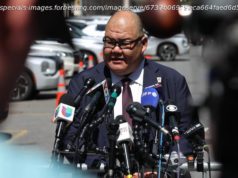Read CNN’s North Korea Fast Facts to learn about the history, population and geography of the Democratic People’s Republic of Korea (DPRK).
Median age: 34.2 years
Capital: Pyongyang
Ethnic Groups: Racially homogenous, small ethnic Chinese and Japanese populations
Religion: Traditionally Buddhist and Confucianist, with some Christian and other sects
GDP (purchasing power parity): $40 billion (2015 est.)
GDP per capita: $1,700 (2015 est.)
Unemployment rate: 25.6% (2013 est.)
Other Facts:North Korea has no diplomatic representation in the United States. They do have a permanent mission to the United Nations.
The United States does not have any diplomatic representation in North Korea. The Swedish Embassy represents the United States as consular protecting power.
A history of North Korea’s weapons program
North Korea missile tests
Timeline:1910-1945 -Japan controls the Korean peninsula.
August 1945 – After Japan surrenders in World War II, the US occupies the southern half of the peninsula while the USSR occupies the northern half.
1945-1994 – Kim Il-Sung is the country’s first leader.
1948 – Separate governments for the northern and southern parts of the Korean peninsula are established after an international stalemate fails to resolve the issue.
June 25,1950 – North Korea invades South Korea. Peace negotiations begin in 1951, but hostilities continue until 1953.
July 8,1994 – Kim Jong Il becomes the leader of North Korea when his father Kim Il-Sung dies.
2000 – Kim Dae Jung, the leader of South Korea, and Kim Jong Il meet for the first time since the country was separated 50 years earlier.
January 10,2003 – North Korea withdraws from the Nuclear Non-Proliferation Treaty.
December 11,2007 – Freight trains begin crossing the border between North and South Korea, resuming a regular service that last ran in the 1950s.
March 3,2008 – After the United States and South Korea begin six days of joint military exercises, North Korea’s foreign minister denounces the exercises and warns that North Korea will explore all countermeasures necessary for its protection. Approximately 27,000 US troops and the aircraft carrier USS Nimitz take part in the exercises.
December 28,2008 – The freight trains that began crossing between the border of North and South Korea in December 2007 suspend service due to souring relations between the two countries, dashing hopes of reconciliation.
March 8,2009 – The Supreme People’s Assembly holds elections, delayed since August 2008. Kim Jong Il is unanimously re-elected in his district, with a reported 100% voter turnout.
June 8,2009 – The state-run media reports that US journalists Laura Ling and Euna Lee, accused of spying, have been sentenced to 12 years in a labor prison.
August 4,2009 -Former US President Bill Clinton sits down with Kim Jong Il to discuss the release of American journalists Lee and Ling. Both women are later given a full pardon from Kim and released.
May 20,2010 – South Korea formally accuses North Korea of firing a torpedo to sink the Cheonan, a South Korean Navy ship, in March, killing 46 sailors. North Korea denies responsibility and warns that any retaliation would lead to “all-out war.”
May 24,2010 – South Korean President Lee Myung-bak severs all trade ties and asks the UN Security Council to punish North Korea.
September 28-29,2010 – North Korea’s ruling party, the Workers’ Party of Korea, meets for the first time since 1980. Kim is re-elected as general secretary of the party.
November 23,2010 – North Korea launches artillery at Yeonpyeong Island in South Korea, killing two South Korean marines.
February 7-9,2011 – Military officials from both North and South Korea meet at the DMZ to defuse tensions and restart international aid talks without much success.
April 29,2011 – The US State Department refutes charges by former US President Jimmy Carter that the United States and South Korea are withholding food aid from North Korea for political motives. The United States had suspended aid two years ago to North Korea, because it suspected the donated food was not reaching those most in need.
April 29,2011 – The UN World Food Programme announces plans to begin emergency food distribution to 3.5 million North Koreans, primarily women and children, who are starving after a harsh winter destroyed crops.
December 17,2011 – North Korean leader Kim Jong Il dies at the age of 69.
December 31,2011 – Kim Jong Un, the youngest son of Kim Jong Il, assumes command of the North Korean army.
December 12,2012 -North Korea successfully launches an Unha-3 long-range rocket from the Sohae Space Center in Cholsan County and puts a “working satellite” into orbit, days after Pyongyang suggested the launch could be delayed.






